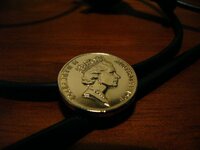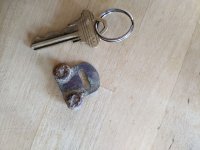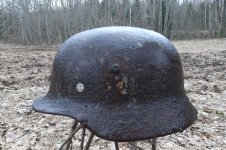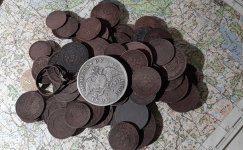Klaatu
Sr. Member
Recently a contractor placing fill dirt found an 1817 Capped Bust half dollar in the soil and discovered (thanks to his son and a Red Book) that the coin was a rare 1817/4 half dollar. Only 7 examples of this overdate had been known prior to his discovery. He cleaned the coin (at the suggestion of a questionable coin dealer) with Tarnex (a very harsh tarnish remover). His coin may have been one of the finest of the 8 now known had he not destroyed the coin's surfaces with that harsh cleaner.
How does cleaning a coin harm it? Think about how brass cleaner or tarnish remover works - it removes the top layer of metal to expose the untarnished metal below. That is fine if you are cleaning a silver fork or a doorknob because there is little or no fine detail to be concerned about - you just want the fork or doorknob to shine. But with a coin the surface details are everything; remove the top layer of metal and say goodbye to some of Liberty's hair detail or the eagle's feather details. Remember that when you sell a valuable coin it will be examined under magnification and damage caused by cleaning will be readily apparent to a knowledgeable buyer. So, it is fine to polish a fork or a doorknob but not a valuable coin.
If the guy that found the 1817/4 half had taken the coin to a professional to have it "conserved" who knows what it may be worth. By using a harsh cleaner he may have turned a $350,000 coin into a $150,000 or $200,000 coin. It is just as easy to change a dug 1916-D Mercury Dime from a $4,400 coin to a $1,500 coin. That is a very expensive lesson.
Think before you clean.
How does cleaning a coin harm it? Think about how brass cleaner or tarnish remover works - it removes the top layer of metal to expose the untarnished metal below. That is fine if you are cleaning a silver fork or a doorknob because there is little or no fine detail to be concerned about - you just want the fork or doorknob to shine. But with a coin the surface details are everything; remove the top layer of metal and say goodbye to some of Liberty's hair detail or the eagle's feather details. Remember that when you sell a valuable coin it will be examined under magnification and damage caused by cleaning will be readily apparent to a knowledgeable buyer. So, it is fine to polish a fork or a doorknob but not a valuable coin.
If the guy that found the 1817/4 half had taken the coin to a professional to have it "conserved" who knows what it may be worth. By using a harsh cleaner he may have turned a $350,000 coin into a $150,000 or $200,000 coin. It is just as easy to change a dug 1916-D Mercury Dime from a $4,400 coin to a $1,500 coin. That is a very expensive lesson.
Think before you clean.


 Thank you for the reminder, Klaatu. Sometimes the temptation to clean stuff can be hard to resist. Happy New Year!
Thank you for the reminder, Klaatu. Sometimes the temptation to clean stuff can be hard to resist. Happy New Year! It makes them look worst...
It makes them look worst...
 .
.







